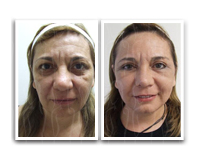Facelift

What is the Face Lift
Also known as Rhytidectomy, facelift is a surgical procedure that restores smoother, more pleasing contours to your face and neck. It can help you look as good as you feel, and perhaps feel younger than you are.
The best candidates for a Facelift
The best candidate for a facelift is a man or woman whose face and neck have begun to sag, but whose skin still has some elasticity and whose bone structure is strong and well-defined. Most patients are in their forties to sixties, but facelifts can be done successfully on people in their seventies or eighties as well. A facelift can make you look younger and fresher, and it may enhance your self- confidence in the process. But it can't give you a totally different look, nor can it restore the health and vitality of your youth. Before you decide to have surgery, think carefully about your expectations and discuss them with your surgeon.
All surgery carries some uncertainty and risk
Complications are infrequent and usually minor. Still, individuals vary greatly in their anatomy, their physical reactions, and their healing abilities, and the outcome is never completely predictable. Complications that can occur include hematoma, injury to the nerves that control facial muscles (usually temporary), infection, and reactions to the anesthesia. Poor healing of the skin is most likely to affect smokers.
What should i expect from a facelift?
Facelift can improving the most visible signs of aging by removing excess fat, tightening underlying muscles, and redraping the skin of your face and neck . It cannot, however, correct conditions such as sagging eyebrows, excess skin and fatty deposits in the upper and lower eyelids, or wrinkles around the mouth. Your plastic surgeon can provide further information if you have an interest in other procedures to treat these areas.







